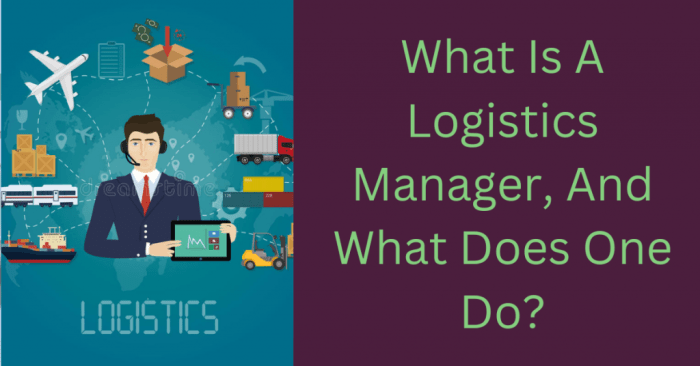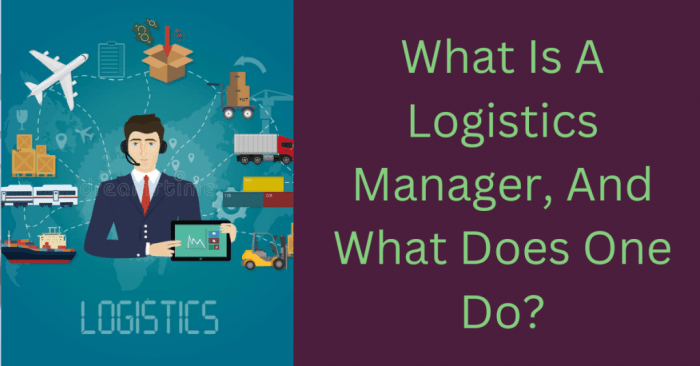
Logistics and Distribution Manager: A detailed look at the role, responsibilities, skills, and trends in today’s dynamic market.
This guide delves into the critical role of a logistics and distribution manager, exploring their daily tasks, essential skills, and the evolving industry landscape. From navigating complex supply chains to optimizing distribution networks, we’ll uncover the key elements for success in this vital position.
Job Description & Responsibilities

A logistics and distribution manager plays a critical role in ensuring the smooth flow of goods from origin to destination. This involves a multifaceted approach encompassing planning, execution, and optimization of every step in the supply chain. From warehousing and transportation to order fulfillment and inventory management, the logistics and distribution manager oversees the entire process, aiming for efficiency, cost-effectiveness, and customer satisfaction.The role requires a blend of operational expertise, strategic thinking, and strong communication skills.
Effective leadership and collaboration across various departments are paramount to success. The position demands attention to detail, problem-solving abilities, and a commitment to continuous improvement in the logistical processes.
Role of a Logistics and Distribution Manager
Logistics and distribution managers are responsible for the planning, execution, and control of all activities related to the movement and storage of goods. This includes the coordination of transportation, warehousing, inventory management, and order fulfillment. Their primary goal is to ensure goods reach their destinations on time, within budget, and in perfect condition. A crucial aspect is maintaining accurate records and documentation throughout the process.
Key Responsibilities and Duties
A key responsibility involves developing and implementing efficient logistics strategies that align with business objectives. This encompasses forecasting demand, optimizing transportation routes, and selecting suitable warehousing facilities. Further duties include managing budgets, negotiating contracts with carriers, and ensuring compliance with all relevant regulations. Another crucial aspect is maintaining strong relationships with suppliers and customers, ensuring seamless communication and timely resolutions of any issues that may arise.Another important responsibility is ensuring the safety and security of goods throughout the supply chain.
This includes implementing appropriate security measures and maintaining accurate inventory records to track goods at all times. Regular monitoring of performance metrics and reporting to senior management is vital to ensure the effectiveness of the logistical operations.
Logistics Manager vs. Distribution Manager
While both logistics and distribution managers focus on the movement and storage of goods, their specific responsibilities differ. A logistics manager typically has a broader scope, overseeing the entire supply chain from sourcing to delivery, including procurement, manufacturing, and warehousing. A distribution manager, conversely, focuses primarily on the distribution network, encompassing warehousing, transportation, and order fulfillment. They manage the movement of goods from the point of origin to the end customer.
The logistics manager is often responsible for the overall efficiency of the entire supply chain, while the distribution manager concentrates on the efficient flow of goods through the final stages.
Typical Daily Tasks and Activities
Typical daily tasks encompass reviewing performance reports, monitoring inventory levels, communicating with stakeholders, and addressing any logistical issues that arise. This often involves coordinating with transportation providers, warehouse staff, and customer service representatives. Other common activities include resolving delivery issues, analyzing data to identify areas for improvement, and planning for future logistical needs. The daily routine is highly dynamic and requires adaptability to changing circumstances.
Required Skills and Competencies
Successful logistics and distribution managers possess a combination of hard and soft skills. Strong analytical skills are essential for evaluating data and identifying areas for improvement. Excellent communication and interpersonal skills are vital for collaborating with various stakeholders. Technical expertise in logistics software and systems is often required. Problem-solving abilities and decision-making skills are crucial for managing complex situations.
Furthermore, a thorough understanding of relevant regulations and compliance requirements is paramount.
Interacting Departments/Teams
| Department/Team | Interaction Points |
|---|---|
| Procurement | Negotiating contracts, ensuring timely material delivery |
| Manufacturing | Coordinating production schedules, managing inventory flow |
| Warehousing | Optimizing storage space, managing inventory, overseeing order fulfillment |
| Transportation | Selecting carriers, negotiating rates, ensuring timely deliveries |
| Customer Service | Addressing customer inquiries, resolving delivery issues, managing returns |
| Sales | Forecasting demand, coordinating with sales teams, managing order volumes |
Skills & Qualifications
A successful logistics and distribution manager needs a diverse skillset encompassing both technical proficiency and interpersonal abilities. This role demands a strong understanding of the intricacies of supply chain management, from warehousing and transportation to inventory control and customer service. The ability to navigate complex challenges and make data-driven decisions is paramount in this fast-paced environment.Effective leadership and communication are essential to coordinating teams and stakeholders.
Ultimately, the manager’s success hinges on their ability to efficiently and effectively manage resources, meet deadlines, and maintain high-quality service levels.
Logistics and distribution managers are key players in any successful business, ensuring smooth operations from warehouse to customer. They need to be super organized and have a knack for problem-solving. Think about how vital their role is in getting products to market, and the importance of efficient strategies for the whole process. Modernizing their approach is essential, and understanding how to effectively use tools like Facebook is crucial for a competitive edge, which is explored in depth in this article on “ready for facebook the verb” ready for facebook the verb.
This will help them understand the nuances of digital marketing and customer engagement, and improve their overall efficiency in their logistics and distribution role.
Essential Technical Skills
Logistics and distribution management relies heavily on technical skills. These skills encompass a deep understanding of supply chain processes, transportation modes, and inventory control systems.
- Warehouse Management Systems (WMS): Proficiency in WMS software is crucial for managing inventory, tracking goods, and optimizing warehouse operations. WMS systems automate many aspects of warehouse management, such as order fulfillment, picking, and packing.
- Transportation Management Systems (TMS): Understanding TMS software is essential for optimizing routes, managing carriers, and tracking shipments. This allows for better control over transportation costs and delivery times.
- Enterprise Resource Planning (ERP) Systems: Knowledge of ERP systems provides a holistic view of the business operations. This includes aspects such as order processing, inventory management, and financial reporting.
- Inventory Management Software: A firm grasp of inventory management software is vital for ensuring optimal stock levels, preventing stockouts, and minimizing holding costs.
- Data Analysis Tools: The ability to utilize data analysis tools, such as spreadsheets and specialized software, to track key performance indicators (KPIs) and identify areas for improvement is essential for making informed decisions.
Crucial Soft Skills and Interpersonal Abilities
Strong interpersonal skills are just as vital as technical proficiency. These skills allow managers to effectively collaborate with diverse teams and stakeholders.
- Communication Skills: Clear and concise communication is paramount in logistics and distribution. This includes verbal, written, and presentation skills. Effective communication ensures that information is relayed accurately and efficiently across the organization.
- Leadership: A strong leadership presence motivates and guides teams towards achieving shared goals. This involves setting clear expectations, delegating tasks effectively, and providing constructive feedback.
- Problem-Solving: Logistics managers constantly face unexpected challenges, from delivery delays to equipment failures. Strong problem-solving skills are critical for identifying and addressing these issues efficiently and effectively. A key component is understanding root causes to implement long-term solutions.
- Teamwork: Collaboration is essential to manage complex logistics operations. The ability to work effectively with cross-functional teams and build strong working relationships with suppliers and customers is critical.
- Negotiation: Negotiating with carriers, suppliers, and customers to secure favorable contracts and terms is a critical skill in this role. The ability to achieve win-win outcomes is highly valued.
Problem-Solving Techniques
Problem-solving is a core competency for logistics managers. It involves analyzing issues, developing solutions, and implementing them effectively.
- Root Cause Analysis: Identifying the underlying cause of a problem is crucial for developing effective solutions. Techniques like the 5 Whys can be used to delve deeper into the issue and pinpoint the root cause.
- Decision Matrices: Using a structured approach, like a decision matrix, can help compare and evaluate potential solutions based on various criteria. This provides a clear framework for decision-making.
- Process Mapping: Visualizing the logistics process allows managers to identify bottlenecks, inefficiencies, and areas for improvement. Flowcharts and process maps help illustrate how tasks are executed and pinpoint areas needing optimization.
Importance of Communication Skills
Clear and effective communication is fundamental in logistics and distribution management.
- Stakeholder Management: Effective communication with customers, suppliers, and internal teams is crucial to ensure smooth operations. This involves regular updates, clear expectations, and proactive issue resolution.
- Conflict Resolution: Communication skills are essential for resolving conflicts, which can arise from various issues in the supply chain. A constructive dialogue can help reach solutions that benefit all parties involved.
- Reporting: Logistics managers need to communicate effectively with management, providing regular reports on performance metrics, potential risks, and any necessary corrective actions.
Value of Analytical Skills
Analytical skills are crucial for making data-driven decisions in logistics and distribution.
- Data Interpretation: The ability to interpret data from various sources, such as sales figures, inventory levels, and transportation costs, is essential for making informed decisions.
- Trend Analysis: Identifying trends in data allows managers to anticipate future challenges and opportunities, and implement proactive measures.
- Predictive Modeling: Predictive modeling allows managers to anticipate future demands, optimize inventory levels, and ensure sufficient resources are in place.
Comparison of Logistics Software
| Software/Technology | Description | Strengths | Weaknesses |
|---|---|---|---|
| Warehouse Management System (WMS) | Manages warehouse operations, inventory, and order fulfillment. | Streamlines warehouse processes, improves efficiency, and reduces errors. | Can be complex to implement and may require significant initial investment. |
| Transportation Management System (TMS) | Optimizes transportation routes, manages carriers, and tracks shipments. | Reduces transportation costs, improves delivery times, and enhances visibility. | Requires integration with other systems, and implementation can be challenging. |
| Enterprise Resource Planning (ERP) System | Integrates various business functions, including logistics. | Provides a holistic view of the business, enhances data sharing, and facilitates cross-functional collaboration. | Can be costly to implement and require significant training for staff. |
Industry Trends & Challenges: Logistics And Distribution Manager
The logistics and distribution landscape is in constant flux, driven by evolving consumer expectations, technological advancements, and global economic shifts. Navigating these complexities requires a proactive and adaptable approach for managers to thrive in this dynamic environment. Staying ahead of the curve is essential for optimizing operations and maintaining a competitive edge.
Current Industry Trends
The modern logistics and distribution industry is characterized by several key trends. E-commerce growth continues to reshape supply chains, demanding faster delivery times and more efficient fulfillment strategies. Sustainability is also a rising concern, with companies increasingly focusing on environmentally friendly practices and reducing their carbon footprint. Globalization, while presenting opportunities, introduces new challenges related to international regulations and cross-border compliance.
Technological advancements are transforming the way goods are tracked, stored, and transported, creating both opportunities and complexities for managers.
Challenges Faced by Logistics Managers
Logistics managers face a multitude of challenges. Rising labor costs and a competitive job market make recruiting and retaining qualified personnel a constant hurdle. Keeping pace with rapidly changing technology and adapting to new software platforms is crucial for operational efficiency. Ensuring supply chain resilience in the face of unforeseen events, such as natural disasters or geopolitical instability, is paramount.
Balancing cost-effectiveness with customer expectations is also a significant challenge. Furthermore, the increasing demand for faster delivery times and personalized services puts pressure on managers to optimize their operations for agility and efficiency.
Impact of Globalization and E-commerce
Globalization has led to increased interconnectedness and complex supply chains. This interconnectedness has created opportunities for companies to access wider markets and resources, but it also complicates the management of international logistics and distribution. E-commerce has further intensified this trend. The surge in online shopping has led to higher volumes of goods moving through distribution networks, requiring more sophisticated fulfillment centers, quicker delivery options, and greater inventory management capabilities.
Importance of Supply Chain Resilience
Supply chain resilience is critical in today’s volatile market. Unforeseen events, such as pandemics, geopolitical conflicts, or natural disasters, can disrupt supply chains, causing significant delays and financial losses. Developing robust contingency plans and diversifying supply sources are essential for mitigating risks and ensuring business continuity. Building relationships with multiple suppliers and establishing alternative transportation routes are key strategies for achieving supply chain resilience.
Impact of Technology on Logistics and Distribution
Technology is revolutionizing the logistics and distribution industry. Real-time tracking systems, automated warehouses, and data analytics tools are transforming operational efficiency and providing insights into supply chain performance. These technologies empower managers to optimize routes, predict demand, and manage inventory more effectively. However, implementing and integrating these technologies requires significant investment and expertise.
Emerging Technologies and Their Impact, Logistics and distribution manager
- Artificial Intelligence (AI): AI-powered algorithms can optimize routes, predict demand fluctuations, and automate tasks like order processing, significantly increasing efficiency and reducing operational costs. Examples include using AI to predict potential disruptions to the supply chain and rerouting shipments proactively.
- Internet of Things (IoT): IoT devices embedded in goods and vehicles enable real-time tracking, monitoring, and condition assessment, leading to improved inventory management, reduced loss, and enhanced security. Tracking the location and condition of goods in real-time can significantly reduce theft and damage.
- Blockchain Technology: Blockchain’s secure and transparent nature can improve supply chain visibility and traceability. This is particularly beneficial in tracking goods across multiple intermediaries and ensures the authenticity of products.
- Drone Delivery: Drones are poised to revolutionize last-mile delivery, offering faster and more efficient delivery options in remote or congested areas. Drones can deliver packages to customers in a shorter time frame than traditional delivery methods.
Key Performance Indicators (KPIs)
Logistics and distribution management hinges on precise measurement and analysis. Effective KPIs provide a roadmap for improvement, guiding decision-making and ultimately boosting efficiency. Understanding these metrics is crucial for optimizing operations and achieving desired outcomes.
Key Performance Indicators for Logistics and Distribution
Tracking key performance indicators (KPIs) is essential for measuring the success of a logistics and distribution manager. Comprehensive KPIs provide a holistic view of the entire operation, enabling proactive adjustments and enhancements. They paint a clear picture of operational strengths and weaknesses, facilitating targeted interventions and improvement initiatives.
Tracking and Monitoring KPIs
Monitoring KPIs requires a robust system for data collection and analysis. This involves utilizing various software tools and platforms to track metrics consistently. Real-time dashboards provide up-to-the-minute insights, enabling swift responses to emerging issues. Regular reporting and analysis meetings are essential for identifying trends and implementing corrective actions.
Evaluating Distribution Network Efficiency
Evaluating the efficiency of distribution networks necessitates the use of multiple KPIs. Metrics like order fulfillment time, on-time delivery rates, and inventory turnover rates provide critical insights into operational effectiveness. Analyzing these metrics allows for pinpointing areas needing improvement and implementing targeted solutions to enhance overall performance. Understanding these metrics also allows for identifying bottlenecks in the process and proactively resolving them.
Logistics and distribution managers are crucial for efficient supply chains, especially in today’s fast-paced world. Imagine the impact on those chains if advancements in optical chip technology, like IBM’s groundbreaking 1TBps holey optical chip, holy semiconductors ibm reveals 1tbps holey optical chip , revolutionize data transfer speeds. These managers need to adapt and optimize their processes to leverage these innovations for maximum efficiency and competitive advantage.
Importance of Data Analysis in Logistics
Data analysis plays a pivotal role in logistics and distribution management. By analyzing data from various sources, such as warehouse operations, transportation networks, and customer orders, logistics managers can gain a deeper understanding of their operations. This deeper understanding allows for identifying trends, predicting future demands, and optimizing resource allocation. The use of predictive analytics enables better anticipation of potential issues, and the ability to adjust operations accordingly.
Using KPIs to Improve Performance
KPIs are not just for measuring performance; they are powerful tools for driving improvements. By setting clear targets and benchmarks, logistics and distribution managers can focus on areas requiring attention. Tracking progress against these targets fosters a culture of continuous improvement, driving teams to achieve better results. Understanding where the bottlenecks exist in the distribution network and how to improve these bottlenecks are crucial to achieving higher efficiency.
Landing a logistics and distribution manager role often hinges on demonstrating your understanding of the industry’s nuances. A key part of this is preparing insightful answers to crucial questions. To really impress potential employers, try using the techniques outlined in this helpful article on “simple one on one questions that pack a punch” simple one on one questions that pack a punch.
By mastering these, you can showcase your problem-solving abilities and strategic thinking, making you a stand-out candidate in the logistics and distribution field.
KPI Table
| KPI | Target Value |
|---|---|
| Order Fulfillment Time (Days) | 3 |
| On-Time Delivery Rate (%) | 95 |
| Inventory Turnover Rate (Times per Year) | 4 |
| Order Accuracy Rate (%) | 99 |
| Warehouse Space Utilization (%) | 90 |
| Transportation Costs per Unit ($) | 10 |
Career Path & Advancement
A successful career in logistics and distribution management hinges on a clear understanding of the path ahead. This involves more than just mastering the day-to-day operations; it requires strategic thinking, adaptability, and a commitment to continuous learning. This section will Artikel the typical progression, highlighting opportunities for specialization and senior leadership roles, and emphasizing the crucial role of professional development.
Typical Career Progression
The logistics and distribution management field offers a diverse range of career paths, starting with entry-level positions and progressing through various levels of responsibility and expertise. Early career stages often focus on building foundational knowledge and practical experience in areas like order fulfillment, inventory management, or transportation planning. As professionals gain experience, they can move into more complex roles involving strategic decision-making, process optimization, and cross-functional collaboration.
Specialization Opportunities
Within the broad field of logistics and distribution, there are significant opportunities for specialization. Professionals can focus on specific transportation modes (e.g., air freight, trucking), industry sectors (e.g., healthcare, e-commerce), or logistical functions (e.g., warehousing, supply chain optimization). Specialization allows professionals to develop in-depth expertise, leading to higher-level roles and increased earning potential.
Continuous Learning and Professional Development
Continuous learning and professional development are essential for career advancement in logistics and distribution management. Staying updated on industry trends, technological advancements (e.g., automation, data analytics), and best practices is crucial for maintaining competitiveness. This often involves pursuing certifications, attending industry conferences, or engaging in self-directed learning initiatives.
Potential Career Advancement Opportunities
Career advancement in logistics and distribution management can involve various roles, from leading specific departments to taking on more strategic responsibilities. Possible advancements include becoming a senior logistics manager, a supply chain director, or even a vice president of operations. The specific path depends on individual aspirations, skills, and the organization’s structure.
Career Progression Table
| Role | Required Experience | Required Education | Typical Responsibilities |
|---|---|---|---|
| Logistics Associate | 0-2 years | Bachelor’s degree (or equivalent) in Supply Chain Management, Logistics, or related field | Order processing, inventory management, basic transportation coordination |
| Logistics Coordinator | 2-5 years | Bachelor’s degree (or equivalent) in Supply Chain Management, Logistics, or related field | Order fulfillment, warehouse management, basic transportation planning |
| Logistics Manager | 5-10 years | Bachelor’s degree (or equivalent) in Supply Chain Management, Logistics, or related field; potentially an MBA | Managing logistics teams, developing strategies, overseeing operational efficiency, and process improvement |
| Senior Logistics Manager | 10+ years | Bachelor’s degree (or equivalent) in Supply Chain Management, Logistics, or related field; MBA preferred | Strategic planning, budget management, team leadership, and cross-functional collaboration |
Tools & Technologies
Logistics and distribution management is increasingly reliant on technology to streamline operations, enhance visibility, and improve decision-making. Modern tools and technologies provide a crucial framework for optimizing processes, tracking goods, and ensuring efficient delivery. This is critical for businesses to remain competitive and adapt to the ever-changing landscape of global trade.
Common Tools and Technologies
Various tools and technologies are employed to manage logistics and distribution effectively. These range from fundamental warehouse management systems to sophisticated data analytics platforms. Their combined use creates a comprehensive approach to optimizing the entire supply chain.
- Warehouse Management Systems (WMS): WMS software solutions manage and track inventory within warehouses. They automate tasks such as receiving, picking, packing, and shipping, reducing manual errors and improving efficiency. WMS solutions often integrate with other systems like transportation management systems (TMS) to provide a unified view of the entire supply chain. For example, a WMS can automatically update inventory levels as items are picked, ensuring accurate records and preventing stockouts or overstocking.
- Transportation Management Systems (TMS): TMS software optimizes transportation routes and schedules. They can calculate the most cost-effective and timely delivery options, considering factors like fuel costs, traffic conditions, and carrier availability. Integration with other logistics tools ensures real-time updates on shipments and allows for proactive adjustments to maintain delivery schedules. For instance, a TMS can identify delays in transit and automatically reroute shipments to mitigate potential delivery problems.
- Real-Time Tracking Systems: These systems provide constant updates on the location and status of goods in transit. GPS technology and mobile applications are common tools for this purpose. Real-time tracking empowers businesses to monitor shipments, anticipate potential issues, and communicate delivery updates efficiently to customers. This increased visibility also enables businesses to manage and respond to disruptions more effectively.
- Geographic Information Systems (GIS): GIS software utilizes maps and spatial data to optimize routes and locations. Businesses can use GIS to analyze factors like traffic patterns, delivery zones, and warehouse proximity to plan the most efficient distribution networks. This can be crucial for businesses that need to plan deliveries based on customer locations, or need to find optimal warehouse placement based on proximity to distribution centers and delivery points.
Data Analysis in Logistics
Data analysis plays a vital role in modern logistics management. By analyzing data from various sources, such as sales forecasts, inventory levels, and transportation costs, businesses can identify patterns, trends, and inefficiencies. This analysis allows for proactive adjustments to optimize the supply chain and improve decision-making. For example, by analyzing historical sales data, a company can predict future demand and adjust inventory levels to avoid stockouts or overstocking.
Real-Time Tracking and Monitoring
Real-time tracking and monitoring are essential for effective logistics management. Modern technologies, such as GPS tracking and mobile applications, allow businesses to monitor the location, status, and condition of shipments in real time. This increased visibility enables proactive adjustments and response to potential issues, which significantly reduces delays and improves customer satisfaction.
Logistics Management Software Comparison
| Software Package | Key Features | Cost (Estimated) |
|---|---|---|
| Company A’s TMS | Advanced routing optimization, carrier management, real-time tracking, and reporting | $10,000-$50,000/month |
| Company B’s WMS | Inventory management, warehouse automation, order fulfillment, and reporting | $5,000-$25,000/month |
| Company C’s Integrated Logistics Platform | Combines TMS, WMS, and other features for end-to-end supply chain management | $15,000-$75,000+/month |
Note: Costs are estimates and can vary based on features, customization, and user volume.
Strategies for Success
Optimizing logistics and distribution is a multifaceted endeavor requiring a blend of strategic planning, operational excellence, and adaptability. Effective strategies are crucial for maintaining profitability, customer satisfaction, and a resilient supply chain. This section explores key strategies to achieve these goals.Successful logistics and distribution management hinges on a holistic approach that considers various interconnected aspects. Strong relationships with suppliers and customers, efficient inventory management, and robust customer service are all critical components.
Risk management and supply chain resilience are paramount to navigate uncertainties and maintain operational continuity.
Optimizing Logistics and Distribution Processes
Streamlining processes through technology implementation, automation, and data analysis is essential for efficiency gains. Implementing real-time tracking systems, advanced warehouse management systems (WMS), and route optimization software can significantly reduce operational costs and improve delivery times. For example, a company using GPS tracking for delivery vehicles can precisely monitor routes, identify traffic congestion, and adjust delivery schedules accordingly, reducing delays and fuel consumption.
Building Strong Relationships with Suppliers and Customers
Cultivating strong relationships with suppliers and customers is crucial for a smooth and reliable supply chain. Open communication, shared goals, and mutual respect foster trust and collaboration. By working closely with suppliers, companies can ensure timely product delivery and address potential disruptions effectively. For instance, a proactive supplier relationship allows for early warning of potential material shortages, enabling timely adjustments in production schedules.
Similarly, strong customer relationships lead to improved order fulfillment and enhanced customer satisfaction. Regular communication and personalized service strategies are key.
Improving Inventory Management
Efficient inventory management is vital for minimizing costs and maximizing profitability. Implementing techniques like forecasting, just-in-time (JIT) inventory, and accurate demand planning can optimize stock levels. By utilizing forecasting models that incorporate historical data and market trends, companies can accurately predict demand, reducing excess inventory and minimizing storage costs. The use of inventory management software can track inventory levels in real-time, providing insights into stock levels and identifying potential issues early on.
For instance, a retail store can use inventory management software to track sales data and adjust inventory levels based on customer demand, reducing waste and ensuring products are available when customers need them.
Enhancing Customer Service and Satisfaction
Excellent customer service is critical for building customer loyalty and driving repeat business. Providing timely and accurate order updates, efficient order fulfillment, and resolving issues promptly are essential elements. Implementing customer relationship management (CRM) systems can improve communication and streamline customer interactions, providing a comprehensive view of customer preferences and needs. For instance, a company using a CRM system can personalize communications, track order progress, and promptly address any customer concerns.
Managing Risk and Ensuring Supply Chain Resilience
Developing a comprehensive risk management strategy is essential for mitigating potential disruptions. Diversifying suppliers, implementing contingency plans, and building strong relationships with stakeholders are critical elements. A company should have a well-defined disaster recovery plan that addresses potential disruptions, such as natural disasters or geopolitical events. For instance, having multiple supplier options for key components allows for a smoother transition if one supplier faces disruptions.
Strategies for Improving Warehouse Efficiency
Improving warehouse efficiency is essential for reducing costs and improving order fulfillment. The following table Artikels strategies for enhancing warehouse operations:
| Strategy | Description | Impact |
|---|---|---|
| Optimized Layout | Strategic arrangement of warehouse space to maximize workflow and minimize travel time. | Reduced labor costs, increased order fulfillment speed. |
| Automation Implementation | Introduction of automated systems such as conveyor belts, automated guided vehicles (AGVs), and robotic systems for picking, packing, and sorting. | Increased productivity, reduced errors, improved efficiency. |
| Inventory Control Systems | Implementing sophisticated inventory management systems for real-time tracking, accurate stock levels, and automated replenishment. | Reduced stockouts, minimized waste, improved order accuracy. |
| Employee Training and Skill Development | Providing employees with comprehensive training on warehouse processes, safety procedures, and new technologies. | Enhanced productivity, reduced errors, improved safety standards. |
| Process Standardization | Developing standardized procedures for order fulfillment, picking, packing, and shipping to minimize errors and optimize efficiency. | Improved consistency, reduced delays, enhanced accuracy. |
Last Point

In conclusion, the logistics and distribution manager plays a crucial role in today’s interconnected world. Success hinges on a blend of technical expertise, strong interpersonal skills, and adaptability to industry trends. By understanding the responsibilities, skills, and challenges, aspiring managers can chart a successful career path in this dynamic field.






